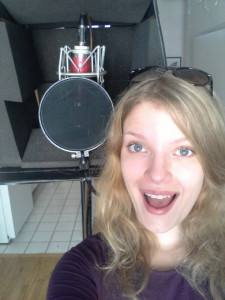Vocal Focus: Peppina — ‘Follow Your Gravity’
Producing the debut EP for an artist means pulling double duty: You don’t just want them to be heard – you want them to be discovered.
That was the mission for Peppina, a singer/songwriter whose music, lyrics and voice have been attracting attention across the globe, from her native Finland clear to LA. Meanwhile, the production team entrusted with recording her premiere release, Follow Your Gravity, was on the job in NYC, ensuring that Peppina’s unique sound would get captured correctly.
Collaborating with Jeff Franzel, Jimmy Landry and Michael Spivack, Peppina was also joined in the studio by the elite session drummer Shawn Pelton (Sheryl Crow, “Saturday Night Live”). The five beguiling pop songs that resulted are already getting notice since the EP’s late February release, and at the core of every track is Peppina’s voice, a striking instrument that’s as expressive as it is beautiful – all the better for broadcasting the unique stories she spins with each verse and chorus.
Tracking vocals for the project was key, and Landry, as a former A&R/in-house producer for Elektra and Capitol Records, was the perfect person to be on point for the job. In this “Vocal Focus”, you’ll learn from Landry the bevy of best practices that went into the sessions – from the x-factor in the signal path to pstudio psychology.
The Voice: Peppina had a ton of rough ideas and rough song demos for me to go through and listen. The first thing I noticed was the actual unique characteristic of her voice. The voice of an artist is so important these days more than ever – with technology it’s easier to get recorded so there are more artists singing.
With Peppina, I instantly noticed that her Finnish accent was working in her favor; and combined with the smooth tone of her innate vocal chords, I was instantly hearing — and picturing — how this could come across in a real-deal recording with great songs.
I had worked with international artists in the past where their accents were not beneficial to them, at least in the American market, and the road of “accent coaching” when cutting vocals is a slippery slope. Peppina’s accent sounds very intriguing in song, and I think this is a beneficial characteristic.
The Studio Strategy: My approach and technique as a producer is different on every song and every artist with regard to vocals. Peppina was very easy because she was not nervous and really knew what she was going for. On the song “Follow Your Gravity”, I actually had Michael Spivack and Jeffrey Franzel with me who wrote the song with Peppina and also co-produced the record with me as a team.
Workflow = there are a lot of intricacies involved. First I have to know the artist’s “law of diminishing returns,” which is balancing how many “takes” to get before tiring out the artist.
With Peppina in general, I started by having her sing the song from beginning to end first to warm up, recording of course, and then I worked backwards by getting the end of the song first. This way I was able to make sure that I had some ending-choruses with a lot of energy and excitement just in case she did get a bit tired.
After that, I started capturing takes starting with the first verse and then moving through the song. I really like to let the artist feel as comfortable as possible and there is a lot of “mental” technique that goes into this. I don’t dig right in with criticism, but instead I go for close-to-keeper takes and then zoom in to perfect after.
I usually end up with five really good takes and then I punch-in some lines afterwards that could be better – I use Cakewalk’s SONAR which has a killer comping system that makes it fast to put vocal tracks together.
What I’m Looking to Accomplish = whatever I need to do to get absolutely the best and most authentic vocal takes out of the artist. I try to make things light and fun as well which I think really helps most artists. I’ve been in those vocal booths back in the day so I know the internal pressure – I try to eliminate that as much as possible.
What I’m NOT looking to do is make the artist feel uncomfortable in any way at all — period.
The Signal Path: I usually have an array of mics and preamps for each recording I do. And depending on the instrumentation and overall drum tone, the choices differ on what I use.
For this track, the mic-pre-comp shootout landed us between an Audio Technica 4033a mic as well as an Avantone CK7 through a Pre-73 MkII and an FMR Audio Compressor. This did the trick for most of the lead vocals on the EP but varied on one or two songs. I do like to record backing vocs with different chains if the vocalist is doing all vocals, which was the case on this record.
My chain is using what I have either from my gear or in a studio to capture the fullest sounding vocal possible. A great mic, a great mic-pre, and a great compressor are really the most important elements.
With that being said, one more part of the chain is just as important that 95% of people overlook –the AD Converter. If you are not using a high-end converter, your awesome mic/pre/comp chain is not going to get the respect it deserves. I would actually invest in good converters over the compressor part of the chain. For this record, we used the converters in the Tascam UH-7000.
Some “special tricks” I use for vocal tracking really have to do with sonic principals and are based on the premise that everything has to find its way into the mix-space. It’s also based on being creative when tracking. The environment around the mic itself is very important – especially when you compress a few times over tracks and busses – the room will really come out at you.
So based on that, sometimes I will do something like switching the mic to a figure-8 mode, and then tracking the bridge of a song in a cool-sounding space. I will literally walk around wherever I am clapping and yelling like a fool to find something special in a space that I think will sound cool in a mix for a vocal “sound.”
Another useful thing people overlook these days is proximity vs. pre-amp (or compressor) gain. If you have the singer back way off the mic and then you crank up your pre (background noise pending of course,) you will find a lot of new and interesting textures that may be useful in the mix space. As cliché as it sounds, experimenting with the gear at hand and the environment will help you to capture some interesting soundscapes that could help in making a more dynamic and dimensional recording.
What’s the Function of Feng-Shui? Funny you should ask this because some of the vocals were actually tracked in Michael Spivack’s apartment in Brooklyn. In order to minimize some not-so-optimal room flutter and noise, we ended up using an interesting apparatus that houses the mic itself (Mike calls it the birdhouse.)
I think the other thing that helped Peppina was the fact that we were not on a clock which I highly recommend. Finding the balance between not being rushed, but delivering a record on time is really important. We would take breaks to enjoy the great tastes of Brooklyn, hang out a bit, etc… When the artist feels comfortable in the complete environment, the vocal performance follows.
Mix Trix: Both Michael Spivack and I mixed the record together, which I have never done before with another mixing engineer. I’m used to mixing solo soup-to-nuts, but I have to say that it was a great experience, mostly because he and I have similar approaches to producing and mixing.
Michael and I quickly adapted to each other’s workflow and strengths, and the outcome was different than my usual mix – in a good way. The interesting thing is that we mixed in SONAR and Michael is used to Pro Tools — I used to be on Pro Tools as well — until I got used to the time-saving workflow of SONAR — so it was a neat controlled experiment.
In terms of “techniques” for mixing this record in the vocal department, the cool thing about SONAR is that it has this feature called “FX Chain Presets” where you can drag a file into the FX rack and it populates with whatever chain you drop. You can create and save your own chains, so basically I have hundreds of FX Chains to start from that are from past sessions. These can have any combination in your arsenal so it’s easy to get creative.
Mixing Peppina’s voice for this record had a pretty basic architecture (or not)… [ON THE TRACK] EQ in SONAR’s ProChannel > (light) compressor > D’esser > Secondary EQ (for any trouble frqs) > light limiter (not always) [OUTPUT] > Master Vocal Bus (light compressor and Air EQ) > Master Bus (glue compressor and more top end EQ) > Interface Output. [SENDs FROM VOCAL TRACK] > 1. > Parallel compression bus dedicated to vocals, 2, 3, 4) FX busses using SONAR FX Chains – Verbs, delays, light modulation, etc.
The other “trick” so to speak is that with Peppina’s vocal, I wanted to get a wide spread while still having it sound intimate and authentic. So I ended up comping 2 other takes – and by using SONAR’s VocalSync, I was able to get them tight to my lead track. I then ran them both at 30% L&R around the lead track and EQ’d and processed them in a way so that they added “space” but didn’t get in the way of the lead comp. The result was a very wide and thick sounding vocal without it sounding like a classic “double.”
Why Voice is So Choice: I have been tracking/mixing vocals for a long time and oddly enough the most satisfying part for me is finding tiny nuances that all add up to making a great recording. Tiny pitch things, writing backing vocal parts, word inflections etc… there are a lot of micro elements that go into it that people don’t realize when they hear it as an end result.
Follow Your Gravity is available now on iTunes.
— Jimmy Landry is a New York City based Music Industry professional who has held A&R and In-House Producer titles at Elektra, Virgin and Capitol Records. He is a songwriter, producer, mixing engineer by trade who was also once signed to EMI as an artist. His diverse music creation background has spanned from songs on ESPN, to Pokémon, to working with artists such as Dilana and Javier Colon.
Please note: When you buy products through links on this page, we may earn an affiliate commission.









